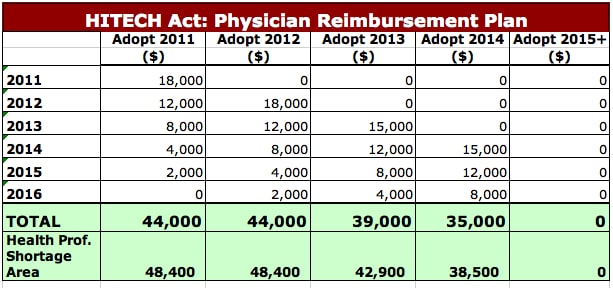 The reimbursement schedule for EHR adoption is aggressive. Over the weekend, we spent more time pouring over the Stimulus Bill, (formerly known as the American Recovery and Reinvestment Act, ARRA), which Obama is scheduled to sign on Tuesday, Feb. 17th.
The reimbursement schedule for EHR adoption is aggressive. Over the weekend, we spent more time pouring over the Stimulus Bill, (formerly known as the American Recovery and Reinvestment Act, ARRA), which Obama is scheduled to sign on Tuesday, Feb. 17th.
Within the ARRA, (Division B, page 489) is a very aggressive schedule to meet the oft-stated deadline of all US citizens having an electronic record of their health by end of 2014. Those physicians that move quickly (demonstrate being a “meaningful EHR user”) will reap the greatest rewards, up to $48,400, through Medicare reimbursements. Those that drag their feet (adopting in year 2015 or later) will end up with zero reimbursement, and worse, in the form of future penalties from CMS.
The following table provides our interpretation of the Medicare physician reimbursement schedule for that $19.2B (we have yet to look closely at reimbursement schedule for hospitals). The Bill also allows for an additional reimbursement of 10% for those physicians providing services in an area designated by the Secretary of HHS as a “health professional shortage area.” At this point, we are assuming that those practices that have already adopted a “certified EHR” and can demonstrate “meaningful use” will be grandfathered-in under ARRA and receive reimbursement.

The aggressive schedule outlined in ARRA raises some real thorny issues that we don’t have the foggiest notion as to how they will be overcome. Those issues are:
With adoption of EMR at the practice/physician level somewhere below 10%, (NEJM puts it at a paltry 4%), do we even have enough IT professionals trained for deploying IT in the healthcare sector? Will demand for HIT professionals far out-strip supply making it nearly impossible to adopt, install, train and demonstrate “meaningful use” in the time frame of ARRA to receive meaningful reimbursement?
How will “meaningful use” be defined and when? Currently, ARRA states (Division B, pg 435) a “meaningful EHR user” as one who demonstrates “meaningful use of Certified EHR technology. We still do not know what a certified EHR is.
As for meaningful use, this includes; eRx, information exchange and reporting on quality measures. eRx is easy to define as CMS has already put this in action. Information exchange is far trickier, but ARRA gives some direction by stating information exchange may be demonstrated by “electronic exchange to improve quality of health care such as promoting care coordination.” As for quality metrics, the preference is for “clinical quality measures that have been endorsed by an entity with a contract with the Secretary.”
To demonstrate meaningful use, the Bill outlines a few approaches including:
- Attestation,
- Submission of claims, electronically of course, with appropriate coding,
- Survey response (whatever that is),
- And a catchall of basically whatever the Secretary may decide appropriate.
Final Analysis
The roll-out of the HITECH Act and the policies requiring far greater elaboration and definition to successfully implement the Act in a timely fashion is going to be extremely challenging. It will require extrodinary leadership and strategic vision at numerous levels within HHS to be successful. With Daschle out, we do not have a Secretary designate to help guide this process. Nor are we completely sure who will ultimately lead ONC, the department within HHS that will be held responsible for actually implementing the HITECH Act. Without that leadership, the HITECH Act is currently a rudderless sailboat, being carried which ever way the wind blows
While we are extremely strong advocates of the need for HIT to become more wide-spread throughout the healthcare sector, we are concerned that the timeline for reimburement that is outlined in ARRA is far too aggressive. Aggressive schedules such as this, while well-meaning, have the very real danger of causing more harm than good. The harm will come in the form of far too many poorly executed HIT deployments by physicians racing to capitalize on the reimburement. While these deployments may meet the “letter of the law” and receive reimburement, over time we predict that the “hassle-factor” as a result of rushed, poorly thought-thru deployments will become ever larger and longer-term meaningful use of EHR will fade.




The incentive payments begin to phase out for providers that do not qualify by fiscal 2013. I think most people believe that providers will still get the large first year payment in fiscal 2014, but the final payments will be cut off by the “no incentive payments with respect to years after 2016” provision. I disagree. The “phase down for eligible professionals” provision leaves me with the impression that the later adopters get whatever the payment the 2013 adopter would have gotten in that year, and the payments get cut off after 2016. Why have the “phase down for eligible professionals” provision in there at all, if the provider still gets the largest payment in the first year? What do you think? For someone who qualifies with 2014 as the first year, I think they will get $12,000 that year.
Here is a somewhat different version, based on a briefing I attended on Capital Hill. Early adopters – those non-hospital physicians who already use EHRs NOW, get an additional $6K payment in 2011. Also:
Aims:
-Make 90% of physicians in the U.S. use the Electronic Health Record (EHR) by 2020 (based on Congressional Budget Office projection).
-Make Health Information Technology ubiquitous.
-Take an aggressive approach towards interoperability of EHRs.
Details:
-$2.1 billion will be available to the Secretary of Health & Human Services for distribution through the Office of the National Coordinator for Health IT (ONCHIT), to enhance interoperability (no electronic silos) and/or at his/her discretion- must be used by end of fiscal year!
-Additional funding (~$4B to HHS secretary).
-$17B allocated for physicians as incentive patyments to use the EHR. These are at least $44K over 3 years per physician (not including physicians working in hospitals) starting in 2011. 70% is front-loaded, payments will be reduced in subsequent years if physician is not actively using the EHR.
-~$11M average payment to hospitals, health systems in bonuses, that have adopted, or will adopt EHR.
-Creation of Federal Coordination Council for Comparative Effectiveness Research (includes NIH, CDC, DOD, etc…).
-Rural physicians, Indian (Native American) and urban underserved populations get substantial funding in the bill (about $2.5B total).
-EHRs must be certified. Although certification process is not yet defined, the AllScripts and WellPoint folks think it will be done through CCHIT. However, language in bill seems to designate NIST as responsible for interoperability and certification.
-3 new federal committes established on standards, certification, etc.
-Substantial payments to states from the Federal government.
Also:
-Additional $10B allocation to the NIH.
-Additional $1.2B allocation to AHRQ.
I have not included payments for Medicaid and Medicare.
Remember – this is for the clinical Electronic Health Record, not the Personal Health Record, Practice Management System, Learning Management System, etc.
John- When you going to release the latest iPHR report?
Does anyone know the timeframe under which, the specifics will be released?
What about physicians who already have and have been using an EHR?
How soon will funds be available and how do you apply for the funds?
Lisa,
This is very much in a state of flux and no clear guidelines have been released. My friends in DC are burning the midnight oil putting that plan together though I can get no firm dates as to when such plans and schedules will formally be released. I’ll be in DC next week, hope to learn more then.
John:
Please note that the guidelines are very clear with regard to timeframe and incentives.
Lisa:
The HITECH incentives are NOT funds that you apply for to help you install an EMR system. The incentives are a “carrot and stick” approach to ensuring widespread adoption of EMR/EHR by physicians. Simply stated, these are incentives in the form of increased (bonus) Medicare/Medicaid payouts for use (meaningful utilization) of certified EMR/EHR systems from Medicare and Medicaid.
If your practice is an early adopter of a CCHIT certified EMR/EHR product, then most of the work is already done, and you just have to ensure you comply with “meaningful use” of that system (once meaningful use is defined.) If you adopt now (or have adopted in the past) and you are “meaningfully” using an EMR when the first incentive payments are distributed by Medicare and Medicaid in 2011, you get a “bonus” to your payout.
If however you have not adopted an EMR/EHR system (or if you have purchased such a system but you are not meaningfully using it), you do not get the dough.
In addition, if you decide you don’t want to adopt an EMR/EHR system, your Medicare/Medicaid reimbursements are PENALIZED (up to 1-5%) starting in 2015.
Translation: If you haven’t installed, get your EMR/EHR system installed now as it takes a while for a practice to work out the pains of EMR/EHR implementation!
If you’ve installed EMR/EHR already, have a trusted adviser help you ensure that your practice complies with the provisions of the HITECH act as they evolve.
Hope this helps out!
T.J. Tavares
Trinity Web Solutions
Gerry:
You state:
I have not included payments for Medicaid and Medicare.
yet you refer these very payments earlier in your post.
-$17B allocated for physicians as incentive payments to use the EHR. These are at least $44K over 3 years per physician (not including physicians working in hospitals) starting in 2011. 70% is front-loaded, payments will be reduced in subsequent years if physician is not actively using the EHR.
To help clear up confusion… the $17B in incentives are payments from Medicare and Medicaid.
Here is a new chart that may help everyone…
http://www.trinitywebsolutions.net/trinitywebsolutionsstimuluspayments.gif
Trinity,
Thanks for taking the time to educate visitors to Chilmark Research on the finer details of the Stimulus Bill and what it means to providers.
I think what is critical to stress to providers is that payment/reimbursement will only come after one demonstrates meaningful use of a certified EHR. Oh how I wish the legislators had left out the word certified as it adds absolutely nothing, actually it is a net detractor.
Regardless, what is important is that payment will only come after one demonstrates meaningful use by mtg the criteria of record sharing in support of care coordination, quality metrics and eRx.
Devil is in the details but it is not too early for physicians to at least begin thinking how they might accomplish meaningful use.
Thank you for the help. I get we’ll just sit tight and wait for the defitinition of “meaningful use”.
Lisa,
The definition of meaningful use will be pretty straight-forward:
1) sharing records electronically in support of care coordination
2) ability to track quality metrics
3) ability to do eRx
The tricky part of the legislation is what does “certified EHR” mean. Is it CCHIT certified, or will there be some other certification body in place. Looks to be leaning to CCHIT, but not a done deal.
John,
Enjoy reading the posts!
Just not sure the definition of meaningful user in the post to Lisa is as straight-forward as presented (but wish it were).
Under criteria for meaningful ehr user (Section 4101 (2) (A) (i)) the professional [is using the EHR] in a meaningful manner, including electronic prescribing.
I know, confusing when a word is used to define itself.
But hopefully by Jan 2010, all will be clarified, including a certified EHR.
Again, enjoy the posts.
Mike Cook
CCIGroup
I have been digging deep into the Medicare and Medicaid programs.
I have not see a good way for a practice to determine if the amount of Allowed Medicare they see on a monthly/annual basis will qualify for the full amount. Does anyone know the calculation?
Thanks,
Mike
Good stuff. So many of the requirements are still foggy. Here are a four arcane questions to which I have not yet found answers.
—————–
I understand that payments are to begin in 2011. Will payments be made in 2011 for calendar year 2010, or in 2012 for calendar 2011. Can you clarify?
——————
My reading of the is that first year payments are $15,000 for adopters before 2012. Does that mean that earlier adopters (e.g. 2010) apply for multiple payments (e.g. covering years 2010 and 2011) in the programs first year.
——————
Can practitioners receive both Medicaid and Medicare incentives, or are they Mutually exclusive. Is there a combined Cap?
I have been trying to keep up on all the different blogs, post, Q&A’s and webinars.
Here is are the answers to the questions based on my research.
1. Hospitals can participate in Medicare and Medicaid. It is clearly stated practices need to select one program and can’t participate in both.
2. They have yet to specify when and how the payments will be made.
3. Each office-based physician who meaningfully uses a certified EHR could receive up to $44,000 (Medicare) or $64,000 (Medicaid) in government funding. Office-based physicians practicing in rural or underserved areas would be eligible for up to $48,400 in Medicare incentives. It’s important to note that these figures represent the maximum allowable incentives under the Medicare and Medicaid programs, and that physicians may only qualify for either the Medicare or the Medicaid funding, but cannot qualify for both.
Medicare reimbursement will start in 2011; physicians are eligible to receive Medicare incentive payments for being a “meaningful user of a certified EHR”. These incentive payments are calculated on a per physician basis. The proposed payments are greatest in the first year, decreasing in amount for the following four years or until 2016. The incentives are calculated up to 75% of your Medicaid Allowed in a the calendar year.
Hope that helps.
Thank you for providing information on meaningful use of EHR’s and how money will reimbursed to the provided. what i was wondering is what happens to a provider who has already implemented or very sonn will be implementing “meaningful EHR” but do not support either medicare or medicaid. how do they get reimbursed? any light on this issue would be helpful.
Ravi,
ARRA funding to reimburse physicians for EHR adoption is being managed through CMS and yes, a physician will need to demonstrate that they indeed serve this patient base. Slightly different terms for each. As I recall, for the higher Medicaid reimbursement, need to have at least 30% of patients receiving some form of Medicaid assistance.
Does the incentive per physician also include other providers such as NPs? If I have to license my NP for use of the EHR, does she qualify for the payment?
Rachel,
The legislation of the HITECH Act only references physicians, thus only licenses sold to a physician qualify for reimbursement.
This, in our opinion is unfortunate as in many practices, the nurses are the true power users of the EHR.
As a Family Nurse Practitioner I was dismayed that Nurse Practitioners are excluded from the Medicare eligible provider definition for incentives in the HITECH Act. However, we can submit comments on the proposed regulations until March 15, 2010. The current regulations include Nurse Practitioners and Nurse Midwives as eligible providers for only Medicaid incentives for use of Electronic Health Records. Currently only physicians, dentists, podiatrists and chiropractors are listed as eligible providers in the Medicare portion of the program. The following is taken from the proposed rules on the CMS website.
Subpart B—Requirements Specific to
the Medicare Program
§ 495.100 Definitions.
In this subpart unless otherwise
indicated—
Eligible professional (EP) means a
physician as defined in section 1861(r)
of the Act, which includes all of the
following types of professionals:
(1) A doctor of medicine or
osteopathy.
(2) A doctor of dental surgery or
medicine.
(3) A doctor of podiatric medicine.
(4) A doctor of optometry.
(5) A chiropractor.
Subpart D—Requirements Specific to
the Medicaid Program
§ 495.304 Medicaid provider scope and
eligibility.
(a) General rule. The following
Medicaid providers are eligible to
participate in the HIT incentives
program:
(b) Medicaid EP. The Medicaid
professional eligible for a EHR incentive
payment is limited to the following:
(1) A physician.
(2) A dentist.
(3) A certified nurse-midwife.
(4) A nurse practitioner.
(5) A physician assistant practicing in
a Federally Qualified Health Center or
Rural Health Clinic, which is so led by
a physician assistant.
I urge you to assess the website and submit your comments regarding changing the “eligible providers” rule to include advanced practice nurses in the Medicare portion of the incentives for use of Electronic Health Records. Please access the site below before March 15 to influence inclusion of advanced practice nurses by using the online public comments for this policy.
http://www.regulations.gov/search/Regs/home.html#submitComment?R=0900006480a7c4a8